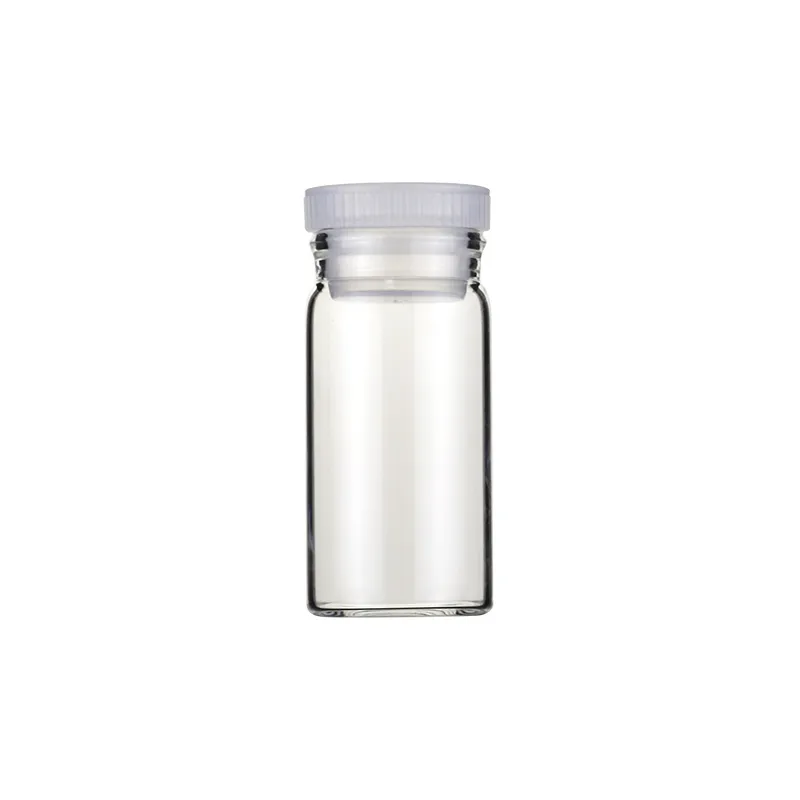Why Shell Vials Are Essential in the Lab?
Introduction
In modern scientific research and clinical diagnosis, laboratories usually need to deal with a large number of samples of great variety. With the expansion of research scale and the increase of sample diversity, how to store these samples efficiently, safely and for a long period of time has become a major challenge in laboratory management. Space constraints, the risk of sample cross-contamination, and the need for sample integrity and traceability have driven laboratories to seek more optimized storage solutions.
Shell vials are micro-containers commonly used for laboratory sample storage and handling. Typically made of glass or high-strength plastics with excellent chemical inertness and mechanical stability, Shell vials are simple in construction and often come with threaded lids or gland seals to ensure that samples are stored in an airtight manner to prevent leakage or contamination. Additionally, shell vials are generally standardized in size for automated instrumentation, batch storage and sorting.
Considerations for Choosing Shell Vials
1. Efficient space utilization
In a laboratory environment where large sample volumes are critical, the small footprint of Shell vials makes them ideal for centralized storage of high-throughput samples. Many shell vials are designed with stackable bottoms and uniform height standards for precise positioning in automated storage systems and robotic manipulation. The accompanying labeling system further optimizes sample sorting and tracking, increasing management efficiency and reducing operational errors.
2. Excellent sealing and security
Another significant advantage of Shell vials is their excellent sealing performance. Most products are equipped with leak-proof threaded caps or embedded sealing gaskets to ensure that samples will not leak, even when dumped, shaken, or exposed to cold temperatures. This feature is particularly useful for storing volatile, toxic or highly reactive liquid samples. In addition, shell vials are often made of chemically inert materials such as borosilicate glass or high-purity polypropylene, which prevents chemical reaction between the sample and the container, thus protecting the stability and purity of sensitive samples, making them suitable for use in extremely contamination-sensitive experiments.
3. Broad compatibility
Shell vials are designed to be compatible with a wide range of laboratory equipment. In the fields of molecular biology, analytical chemistry and cell biology, they are widely used in scenarios such as PCR reaction systems, liquid/gas chromatography sample processing, short-term culture and frozen storage of cell samples. Thanks to their standardized dimensions and robust construction, shell vials can be directly adapted to a wide range of commonly used instruments.
Application Scenarios and Case Studies
1. Molecular biology
In molecular biology research, where DNA and RNA samples are extremely sensitive to temperature, enzymatic degradation and trace contamination, Shell vials provide a stable, contaminant-free microenvironment for nucleic acid samples thanks to their excellent sealing and inert materials. Its small volume design also helps reduce the operating volume required for repeated freeze-thawing, reducing the risk of degradation. Many laboratories choose to use shell vials made of borosilicate glass for long-term storage of extracted nucleic acids, ensuring that the integrity of the samples remains intact at extreme temperatures such as -80°C.
2. Clinical Laboratories
In clinical diagnostic scenarios, shell vials are widely used for the storage and transportation of serum, plasma, urine and other biological samples. The use of shell vials with sealed lids not only prevents the leakage of biohazardous substances, but also supports the cold chain management of specimens at low temperatures, which is in line with international standards for the transportation of biohazardous materials. Compared to traditional tubes, shell vials are more suitable for small-dose, high-density specimen collection and storage.
3. Pharmaceutical and chemical industry
In the field of pharmaceutical and chemical analysis, shell vials are often used to store highly active compounds, drug intermediates or precision standards. These substances are extremely sensitive to light, air or moisture, and the inert materials and sealing properties of shell vials effectively insulate them from environmental influences. Some pharmaceutical companies even use customized shell vials for the long-term storage of reference substances or calibration solutions to ensure product consistency and traceability.
4. Advantages of Shell vials over traditional storage tubes
Compared to traditional screw-cap plastic centrifuge tubes or universal tubes, shell vials are superior in preventing cross-contamination of samples and evaporative loss. Conventional tubes are susceptible to sample volatilization, concentration changes, and even microbial contamination during prolonged storage or frequent opening of the cap. Shell vials reduce these risks due to their tight sealing construction and chemical resistant materials.
Considerations for Choosing Shell Vials
In order to ensure the reliability of the experimental data and the security of the samples, choosing the appropriate shell vials is a link that should not be ignored. The following aspects can be used as important references when purchasing and using shell vials.⬇️
1. Material selection: glass vs. plastic
Shell vials are mainly made of glass (e.g. borosilicate glass) and polymer plastic (e.g. polypropylene or polyethylene). Glass is resistant to high temperatures and chemicals and does not react easily with samples, making it suitable for applications that require extremely high purity or autoclaving. However, it is costly and fragile. In contrast, plastic shell vials offer high impact resistance and cost advantages for ambient storage, single use or on-site sample collection. In addition, light transmission is also a selection criterion; clear glass facilitates visual observation of samples, while partially opaque plastic helps protect photosensitive substances from light.
2. Sealability testing: scenarios for different lid types
The sealing performance of Shell vials plays a decisive role in preventing leaks, volatilization and contamination. Depending on the needs of the experiment, the right type of lid should be selected. The gland type seal is commonly used for high pressure liquid chromatography sample processing, which is more airtight but requires a special capping tool. Duyu frozen storage or long-distance transportation scenarios, it is recommended to conduct a sealing test at the time of purchase to ensure that the selected vials can withstand extreme temperatures or physical shocks.
3. Standardization and certification requirements
High-quality shell vials should comply with international or industry standards, such as ISO 9001 quality system certification, USP (United States Pharmacopeia) or EP (European Pharmacopeia) regulations. For biological and molecular applications, some shell vials also need to be certified for five RNAase/DNAase contamination to ensure that sensitive samples are stored safely without interference from exogenous nucleic acids. The standardized dimensions and scale design also facilitate compatibility with existing laboratory equipment, improving operational efficiency and experimental reproducibility. Therefore, during the procurement process, brands and suppliers with complete product information, test reports and third-party certification should be prioritized.
Future development and innovation
1. Smart trend: QR code/RFID tag integration
- Full-process traceability: Record the production batch, sterilization expiration date, opening time, etc. of consumables through the unique identification code, and link with the laboratory LIMS system to realize inventory warning and automatic scrapping reminder.
- Experimental data correlation: Scanning the label can directly access the consumables related parameters, reducing human error.
- Anti-counterfeiting and compliance: Blockchain technology can verify the source of consumables to ensure the authenticity of biosafety or GMP certification.
Challenge
-
- Need to balance costs and benefits and prioritize rollout in high-value consumables.
- Compatibility: Uniform data interface standards need to be developed to accommodate different brands of equipment.
2. Sustainable materials: degradable/recycled design
- Bio-based materials: compostable plastics such as polylactic acid (PLA) and PHBV for short-term use scenarios such as petri dishes and gun tips.
- Closed-loop recycling: establish a recycling program for laboratory consumables; design modular consumables.
- Green process: Reduce solvent use in the production process, e.g., ultrasonic welding instead of gluing.
Implementation Difficulties
-
- Degradable materials can be reins sacrificing transparency or mechanical strength, and need to optimize performance through nanocellulose enhancement and other technologies.
- Policy push: e.g. EU SUP ban extends to labs, forcing the industry to transform.
3. Customization requirements: function-oriented design
- Adaptation to extreme conditions: anti-cracking design for ultra-low-temperature (-80°C) freezing tubes; label ink resistant to organic solvents.
- Special experimental needs: light-proof PCR tubes (with carbon black coating); low adsorption pipette tips (for micro samples).
- Marketing strategy: flexible production to meet small customized orders. Consumables standardization with head labs.
4. Suggested directions for extending innovation
- Miniaturization and integration: microfluidic chip integrates sample processing and detection functions to reduce the use of consumables.
- Intelligent response materials: temperature-sensitive color-changing labels (visual indication of whether the cryopreservation tubes are experiencing abnormal warming).
Implementation pathway
- Prioritization assessment: short-term focus on high value-added areas, long-term layout of sustainable technologies.
- Cross-border cooperation: joint material science, loT, biotech companies to break through technological bottlenecks.
- User education: Prove TCO (Total Cost of Ownership) advantages of innovative consumables through white papers and case demonstrations.
Conclusion
As an important tool for laboratory sample storage, Shell vials stand out for its compact and flexible design, excellent sealing performance, and high standardization compatibility in a variety of scientific research and clinical applications. Whether it’s protecting nucleic acids in molecular biology, transporting biological samples in clinical diagnostics, or preserving highly active compounds in pharmaceutical and chemical experiments, shell vials provide a reliable and efficient sample management solution for lab technicians.
Compared to traditional sample containers, shell vials reduce the risks of cross-contamination, sample volatilization and handling errors, and significantly improve the accuracy and reproducibility of experimental data. This irreplaceable safety and adaptability has made shell vials one of the preferred containers for high-throughput experiments and high-standard experimental environments.
In the future, as laboratory automation and miniaturization technologies continue to advance, shell vials are expected to be further optimized in terms of functionality and materials, such as higher performance sealing systems, smart label tracking technology, environmentally friendly recyclable materials, and other new designs will continue to emerge. These innovations will continue to drive laboratory sample management towards greater efficiency, safety and sustainability.

 Italiano
Italiano Português
Português
